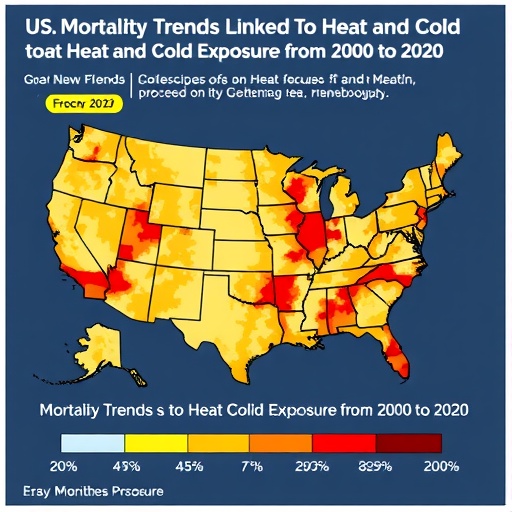Recent research published in JAMA Network Open elucidates the profound impacts of nonoptimal temperatures on mortality rates, underscoring a critical intersection of environmental science and public health. This extensive case series provides a nuanced analysis of how deviations from optimal temperature ranges contribute significantly to the mortality burden worldwide, with implications that reverberate through the fields of climatology, epidemiology, and demography. By focusing on temperature-related mortality, this groundbreaking study illuminates the intricate web of factors—including geographic location, cause of death, and demographic vulnerabilities—that exacerbate the health consequences of climate variability.
At the core of the study lies the recognition that both extreme heat and cold exert deleterious effects on human health, yet the extent of these effects is far from uniform across populations or regions. The researchers meticulously analyzed mortality data in conjunction with temperature records, enabling them to tease apart the complex relationships that underpin temperature-associated deaths. The findings decisively indicate that nonoptimal temperatures act as a critical environmental determinant of mortality, with variations in risk profiles corresponding closely to local climatic conditions and population characteristics.
Environmental temperature acts as an omnipresent and powerful modulator of physiological homeostasis. When ambient temperatures drift beyond the human body’s thermoregulatory capabilities—either into extremes of heat or cold—there is an increased physiological strain that can precipitate or exacerbate a range of medical conditions. Cardiovascular, respiratory, and renal diseases, in particular, demonstrate heightened sensitivity to temperature fluctuations, often culminating in elevated mortality rates during temperature extremes. This physiological susceptibility is further compounded by societal and infrastructural factors such as housing quality, access to healthcare, and behavioral adaptations.
Geographical variability emerges as a pivotal factor influencing the degree to which populations bear the burden of temperature-induced mortality. Populations dwelling in temperate zones, which traditionally experience more moderate temperature ranges, might exhibit different vulnerability patterns compared to those in tropical or polar regions. Moreover, urban heat islands intensify heat exposures in metropolitan areas, disproportionately affecting urban residents. Conversely, populations in colder climates may face a heightened threat from cold spells, especially if adequate heating infrastructure or insulation is lacking.
Demographic stratification reveals that not all population groups are equally vulnerable to temperature-related mortality. Age plays a critical role, with the elderly and very young disproportionately impacted due to diminished thermoregulatory efficiency and comorbidities. Socioeconomic status also modulates risk, as individuals with limited resources may lack access to cooling or heating mechanisms, increasing exposure risks. The study’s granular approach sheds light on these differential vulnerabilities, advocating for tailored interventions that consider these demographic intricacies.
One of the study’s salient contributions is its elucidation of cause-of-death specificity in relation to temperature effects. For example, ischemic heart disease and stroke fatalities surge during both heat waves and cold snaps, highlighting the cardiovascular system’s sensitivity to thermal stress. Respiratory conditions, including chronic obstructive pulmonary disease and pneumonia, also demonstrate pronounced mortality rises linked to temperature deviations. This specificity underscores the need for targeted clinical awareness and public health preparedness strategies designed to mitigate temperature-triggered exacerbations of these conditions.
The implications for public health policy are profound and immediate. Given the inexorable progression of climate change—manifesting in more frequent, intense, and prolonged temperature anomalies—the quantification of temperature-related mortality gains urgency. The study advocates for integrated policies that blend climate adaptation strategies with health protection initiatives. Such approaches must be localized to respond to regional climatic realities while factoring in local health infrastructure and population vulnerabilities, thereby maximizing effectiveness.
From a climate science perspective, the recognition of temperature as a determinant of mortality bridges the gap between abstract meteorological phenomena and tangible human health outcomes. This study’s methodology, combining epidemiological data with granular temperature records, exemplifies the power of interdisciplinary research to unravel multifactorial problems. It also signals the necessity for further advancement in predictive modeling that incorporates demographic and geographic nuances to forecast temperature-related health impacts with greater precision.
In practice, the development of early warning systems that alert communities to impending extreme temperatures can be lifesaving. Coupled with community education programs and infrastructure improvements—such as urban greening to mitigate heat islands or enhanced insulation for cold climates—the potential to reduce temperature-related mortality is significant. The study’s findings thus provide a scientific basis to galvanize investment and innovation in these critical areas.
Furthermore, the healthcare system must adapt to the emerging challenges posed by temperature extremes. This includes augmenting surveillance of temperature-sensitive health conditions, bolstering emergency response capabilities during heat waves and cold spells, and ensuring equitable access to preventive measures and treatments. Tailored clinical guidelines that recognize temperature as a modifiable risk factor could transform management paradigms for vulnerable patient populations.
Importantly, this study also highlights gaps in current knowledge. While it provides robust evidence linking nonoptimal temperatures to excess mortality, the dynamic interplay of additional environmental stressors—such as air pollution and humidity—and social determinants remains an area ripe for further investigation. Better understanding these interactions could refine risk assessments and improve intervention strategies.
In conclusion, this comprehensive case series delivers compelling evidence that temperature extremes are a significant and modifiable driver of mortality globally. With climate change poised to exacerbate these exposures, there is a clarion call for urgent, context-sensitive, and demographically targeted public health responses. By integrating scientific insights into policy and clinical practice, it is possible to mitigate the silent but substantial toll wrought by environmental temperature deviations, protecting vulnerable populations and enhancing resilience in the face of a changing climate.
Subject of Research: Mortality burden attributable to nonoptimal environmental temperatures and the interaction with demographic, geographic, and health factors.
Article Title: Not provided in source content.
News Publication Date: Not provided in source content.
Web References: Not provided in source content.
References: doi:10.1001/jamanetworkopen.2025.42269
Keywords: Mortality rates, Temperature, Public health, Geography, Climate change, Demography, Heat, Environmental health




